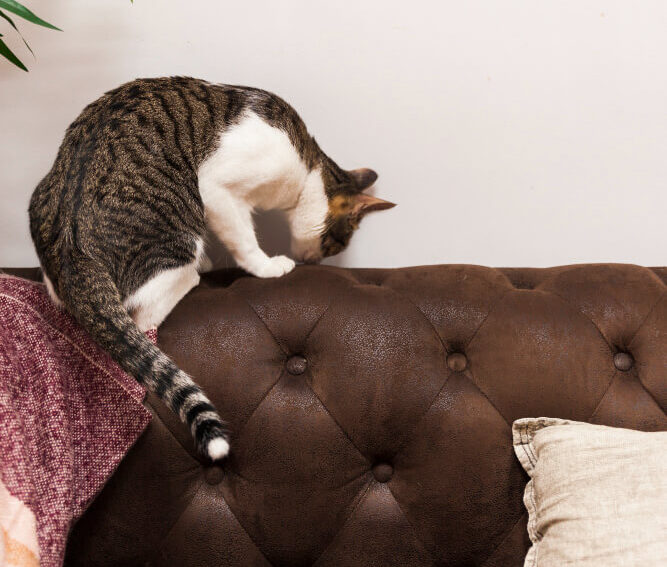The 60-Second Scratch Test: Find Your Cat’s Motive
Watching your cat sink its claws into your favorite leather couch is a uniquely frustrating feeling. It’s easy to take it personally, but here’s the secret: your cat isn’t trying to ruin your decor. Scratching is a completely natural and instinctive behavior.
The key to stopping your cat from scratching your leather furniture isn’t about punishment it’s about understanding the why behind the action. Think of yourself as a detective, and this 60-second quiz is your first clue. By pinpointing your cat’s primary motive, you can choose a targeted solution that actually works, instead of wasting time and money on random tips.
Ready to crack the case? Let’s begin.
Question 1: Where is the main scratching happening?
- A) The arms and the top of the backrest. If this is the scene of the crime, your cat is likely a “Territory Marker.” These are prominent spots where their visual marks (the scratches) and scent (from glands in their paws) will be most noticeable. They’re basically putting up a “I live here” sign on your leather sofa.
- B) The corners and sides. If the damage is on the edges, you’re probably dealing with a “Texture Seeker.” Your cat has simply discovered that the sturdy, textured surface of your leather couch is perfect for giving their claws a good manicure and a satisfying stretch.
Question 2: When does the scratching usually occur?
- A) When you walk in the door or when there’s commotion. This points to scratching driven by excitement or anxiety. The sudden activity puts them on alert, and marking their territory helps them feel secure again.
- B) After a long nap. This is the simplest motive! They just woke up and need a glorious, full-body stretch. Your couch is simply the most convenient and stable object to use.
Your Quick-Result Guide:
Mostly A’s: Your cat is a Territory Marker. Head straight to Solution #2 for the best deterrent strategies.
Mostly B’s: Your cat is a Texture Seeker/Stretcher. Solution #1 is your golden ticket to saving that leather furniture.
Now that you know the “why,” let’s get to the “how to fix it.”
The Ultimate Solution Menu: Match a Fix to Your Problem
Now that you know your cat’s type, choose your targeted solution to stop cats from scratching furniture.
For the “Texture Seeker”:
Your cat loves the feel of leather. Provide a better texture! A tall, sturdy sisal rope scratching post placed right next to the couch is your best bet. Rub it with catnip to make it the new favorite spot. This is the perfect way to redirect cat scratching behavior.
For the “Territory Marker”:
You need to make the couch a “no-scratch” zone. Apply double-sided sticky tape to the arms. Cats hate the sticky feel.
You can also use a homemade citrus spray (test first!) as a natural cat deterrent for leather furniture.
For the “Attention Getter”:
Stop the yelling it’s a reward for them! Instead, use positive reinforcement. Keep treats near the new scratching post.
When they use it, give them a treat and praise. This teaches them where scratching does pay off.
3. The Quick-Fix Kit: 5 Things to Buy Now
Don’t overcomplicate it. Here’s your simple shopping list for protecting leather furniture from cats:
- Double-Sided Sticky Tape: The fastest way to make the couch unappealing.
- A Tall, Sturdy Sisal Post: Provides the perfect scratching alternative.
- Feliway Pheromone Spray: Calms territory anxiety and makes posts more attractive.
- A Clicker: For clear training communication.
- High-Value Treats or Catnip: The reward that makes new habits stick.
This kit tackles the problem from all angles, giving you everything you need for a successful DIY faux leather repair of your cat’s habits.
4. The Pro’s Playbook: 3 Tricks You Haven’t Tried
Go beyond the basics with these pro secrets for living with cats and leather couches:
- The “Sofa-Side Saloon”: For the first two weeks, place the new scratching post directly in front of the damaged couch spot. Convenience wins!
- The “Scent-Soak”: Rub catnip on the new post. Then, wipe the couch with a citrus-scented cloth. This makes the post the more attractive option.
- The “Toe-nail Test”: If your cat’s claws get stuck on everything, they’re too long. Regular trims reduce their need to scratch.
5. Damage Control: Fixing Scratches
Already have scratches? Don’t worry. For light marks, a good leather conditioner can often minimize their appearance.
For deeper gashes, a leather filler kit with matching dye can work wonders, making your repair of cat scratches on leather nearly invisible.
6. 3 Mistakes That Make It Worse
Avoid these common errors that undermine your progress:
- Moving the Post Too Soon: Wait until it’s their favorite spot before slowly moving it.
- Using a Wobbly Post: If it tips over, your cat will never trust it again.
- Reacting with Anger: This only teaches your cat to be afraid of you, not to stop scratching.
Quick-Answer FAQ
Q: Best immediate deterrent?
A: Double-sided sticky tape. It’s safe and feels unpleasant on their paws.
Q: Will a spray bottle work?
A: No. It creates fear, not a solution.
Q: My cat ignores the new post!
A: Try a different material like cardboard and soak it in catnip. Find their preference!


